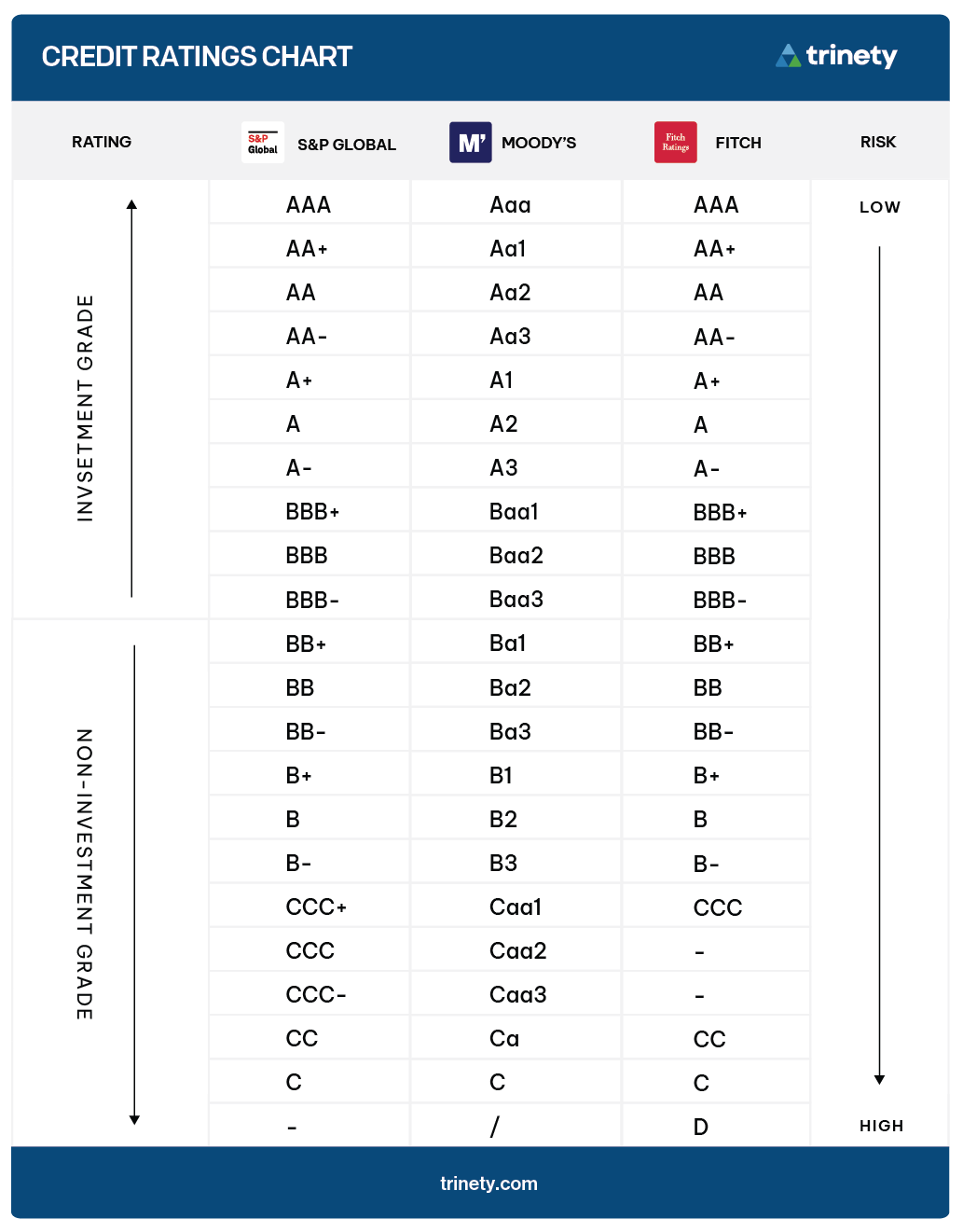Guide to Tenant Credit Ratings
When considering a net lease investment, the financial strength of the tenant is one of the most critical factors. Tenant credit ratings serve as an indicator of their likelihood to meet rent payments throughout the lease term, impacting property performance, risk exposure, and even the residual value. This guide will break down how these ratings work, the differences between investment-grade and non-investment-grade tenants, and how they can affect financing terms. Understanding tenant credit ratings can significantly influence decision-making when evaluating potential net lease investments.
How Tenant Credit Ratings Work
Tenant credit ratings are provided by agencies like Standard & Poor’s (S&P), Moody’s, and Fitch, and they serve as a scorecard reflecting a company’s financial stability. These ratings can range from AAA, the highest, to D, which indicates default. The primary purpose of these ratings is to assess the creditworthiness of a tenant, providing landlords with an objective measure to gauge the likelihood of rent payments being fulfilled throughout the lease term.
Key Components of Credit Ratings:
• Financial Health: Credit ratings analyze financial statements, including revenue, debt levels, and profitability.
• Market Position: Tenants with a strong market presence often have higher ratings due to consistent revenue streams.
• Risk of Default: Lower-rated tenants pose a higher risk of default, which impacts not only rent collection but also the future value of the asset.
Investment Grade vs. Non-Investment Grade
A key distinction in credit ratings is between investment-grade and non-investment-grade tenants. Investment-grade ratings typically fall within the Baa3 or higher range (S&P/Fitch) or BBB- or higher (Moody’s), signaling lower risk.

Investment-Grade Tenants:
• Stable Payments: Higher likelihood of consistent rent payments throughout the lease term.
• Lower Risk: Associated with lower default rates.
• Positive Impact on Cap Rates: Investment-grade tenants often lead to more favorable cap rates, which directly affect the property’s valuation and residual value.
Non-Investment-Grade Tenants:
• Increased Risk: A rating below BBB- or Baa3 signifies a higher risk of default.
• Higher Cap Rates: Non-investment-grade tenants typically result in higher cap rates due to the elevated risk.
• Potential for Higher Yields: Investors may benefit from higher returns if they are willing to assume the additional risk.
Private Companies and Credit Ratings
For private companies that do not have publicly available credit ratings, assessing tenant creditworthiness can be more challenging. In these cases, landlords and investors typically rely on alternative methods such as financial disclosures, third-party due diligence reports, or tenant credit risk assessments performed by private agencies.
Assessing Private Companies:
• Financial Statements: Review of audited financial reports, including income statements and balance sheets.
• Industry Position: Evaluation of the company’s market position, competitive landscape, and revenue stability.
• Credit Risk Tools: Utilizing proprietary risk rating models from third-party providers when public ratings are unavailable.
Impact on Residual Value and Cap Rates
Tenant credit ratings not only influence the stability of rental income but also have a direct impact on property valuation through the capitalization rate (cap rate). A stronger tenant credit rating often results in lower cap rates, signaling lower risk and increasing the property’s residual value.
Influence of Credit Rating on Cap Rates:
• Investment-Grade Tenants: Typically result in lower cap rates due to reduced risk, which enhances the asset’s value.
• Non-Investment-Grade Tenants: Higher cap rates reflect the additional risk, often leading to lower overall property valuation.
A tenant’s credit strength can also affect the potential to sell or refinance the asset. Higher ratings enhance liquidity and make the property more attractive to buyers and lenders alike.
Financing Terms and the Role of Credit Ratings
Tenant credit ratings play a critical role in determining the terms and conditions of financing. For instance, CMBS loans may include specific provisions tied to tenant credit ratings. In particular, if a tenant’s rating drops below investment grade, lenders may enact a cash sweep provision, where rental income is diverted to a reserve account to protect the lender’s interests.
Financing Impacts:
• Preferred Terms for Investment-Grade Tenants: Lenders often offer more favorable financing terms, such as lower interest rates and higher loan-to-value ratios.
• Cash Sweep Provisions: When a tenant’s rating falls below investment grade, CMBS lenders may enforce a cash sweep, meaning all rent proceeds are used to pay down the debt rather than being distributed to the investor.
• Impact of Downgrades: A tenant downgrade can trigger increased reserve requirements, higher interest rates, or even default provisions in the financing structure.
Conclusion
Tenant credit ratings are a vital tool for assessing the strength and reliability of a tenant in a net lease investment. Whether dealing with public or private companies, understanding how these ratings impact cap rates, residual values, and financing terms is critical for making informed investment decisions. Investors who take the time to evaluate tenant credit ratings can enhance their ability to mitigate risk and improve the financial performance of their net lease investments.
Questions or comments for the team?
Send us an email at info@trinety.com or give us a call at 805-TRINETY (874-6389)










